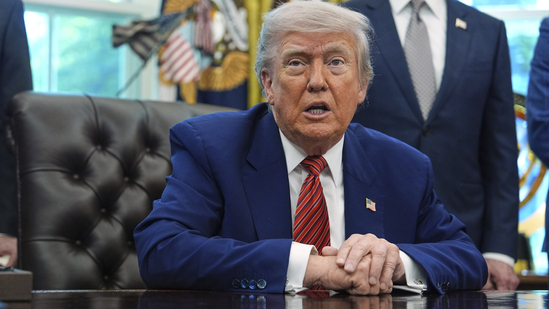In a bold move that could significantly impact the global tech industry, former President Donald Trump has once again put Apple Inc. in the spotlight. Trump recently declared on his Truth Social platform that he expects Apple to shift iPhone production to the United States — or face a 25% tariff on imported products. This announcement forms part of a broader push to bring high-tech manufacturing back to American soil and reduce reliance on foreign supply chains.

Trump’s Bold Stance on Domestic Manufacturing
A Longstanding Agenda
Trump’s message is not new. Since his first term, the former president has made it clear that he favors American-made products. He claims to have directly informed Apple CEO Tim Cook about his expectations regarding iPhone manufacturing in the U.S. The latest tariff warning intensifies this pressure, with Trump aiming to transform American economic policy by revitalizing domestic manufacturing.
Escalating Trade Tensions
Trump didn’t stop at Apple. He also announced plans for a 50% tariff on European Union imports beginning June 1. This signals a broader return to aggressive trade policies, should he reclaim the presidency.
The Supply Chain Puzzle: Why Apple Can’t Shift Overnight
Apple’s Asian Manufacturing Roots
Apple has spent decades building a complex supply chain across Asia, particularly in China. These facilities—often spanning thousands of workers and enormous campuses—are difficult to replicate in the U.S. Key manufacturing partners like Foxconn have optimized their operations around Asia’s infrastructure, cost-effectiveness, and access to skilled labor.
Why the U.S. Lags Behind
The U.S. currently lacks the dense network of suppliers, logistical support, and technical expertise required for Apple’s large-scale production needs. While Apple is capable of assembling smaller products domestically—such as the Mac Pro—the iPhone’s volume and complexity present a monumental challenge.
Financial Impacts of Trump’s Threat
Stock Market Reacts
Trump’s tariff announcement didn’t go unnoticed by the markets. U.S. equity futures dipped following his statement, with Nasdaq 100 contracts showing noticeable declines. Apple shares alone dropped by up to 4% in pre-market trading—a signal of investor concern over increased geopolitical and trade risks.
Apple’s Tariff-Related Woes
Earlier this month, Apple warned of $900 million in additional costs this quarter due to tariffs. Now, with fresh threats from Trump and pressure to halt production expansions in India, Apple is caught in a geopolitical crossfire.
Tim Cook’s Balancing Act with Washington
From Friendly Ties to Political Tensions
During Trump’s first term, Tim Cook maintained a pragmatic relationship with the administration, managing to secure key tariff exemptions. However, the tone has shifted. Trump’s repeated focus on Apple suggests a breakdown in that relationship.
“It’s a red flag for me that Trump continues to single out Apple,” said Randy Hare of Huntington National Bank. “You can’t predict what’s coming next, and that makes investors nervous.”
Navigating Political Landscapes
Cook has also worked closely with leaders across the political spectrum. After the 2024 election, he joined a meeting at Mar-a-Lago attended by tech magnates like Elon Musk and Jeff Bezos—further evidence of Apple’s need to stay diplomatically agile.
Can Apple Bring iPhone Manufacturing Home?
Investment in U.S. Infrastructure
To Apple’s credit, the company has already pledged to invest $500 billion in the U.S. over four years. This includes expanding its server manufacturing facility in Houston and deepening its partnerships with U.S.-based suppliers.
The Automation Debate
Some have proposed that Apple leverage its financial power to build fully automated production lines in the U.S. However, experts argue that these ideas are not yet practical. Apple’s supply chains rely heavily on human labor and Chinese-made machinery, which complicates automation efforts.
The Bigger Picture: Trade, Tech, and Politics
This development raises broader questions about the intersection of trade policy and the tech sector. Trump’s renewed focus on tariffs as a tool to bring jobs back to America will likely remain a key issue as the 2024 election cycle heats up. Apple, as one of the most visible and valuable tech companies in the world, finds itself at the center of that debate.
Frequently Asked Questions:
Q1: Why is Donald Trump threatening Apple with tariffs?
A: Trump wants Apple to move iPhone manufacturing to the United States and reduce its reliance on foreign supply chains, especially China.
Q2: What would a 25% tariff mean for Apple?
A: A 25% tariff on iPhones could raise production costs significantly, impact profit margins, and potentially lead to higher prices for consumers.
Q3: Has Apple responded to the tariff threats?
A: As of now, Apple has not issued an official response. The company has previously cited major logistical challenges in shifting production to the U.S.
Q4: Can Apple really manufacture iPhones in the United States?
A: While not impossible, it would be extremely difficult due to the lack of infrastructure, labor, and supply chain integration currently available in the U.S.
Q5: What’s the potential impact on global trade?
A: This move could reignite trade tensions with China and the EU, potentially affecting not only Apple but also other tech and manufacturing firms.




